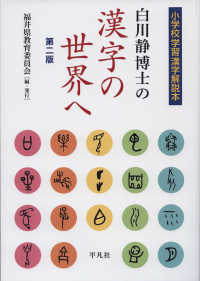- ホーム
- > 洋書
- > ドイツ書
- > Humanities, Arts & Music
- > Music
- > history of music
Description
(Text)
The background to this third volume of Italian Opera in Central Europe, 1614-1780 is the emergence of the new genre of opera in Italy around 1600 and its development and dissemination in Central Europe between 1614 and c. 1780. The present volume explores more thoroughly the European dimension of Italian opera. This practice fulfilled a complex function as a medium of representation; artists contributing to opera were mediators of ideas and images in the network of European cultural relations. Opera patrons required individual artistic achievements to enhance the prestige of their ancestral houses in the competition of the dynasties. On the other hand, a general system of ethical-political values encouraged the use of universal topics and symbolic meanings. In the courtly context, some universal occasions for the staging of operas, such as marriages, coronations, noble births, carnivals and fairs, led to repetition of the subjects covered, while the reliance upon a limited numberof mythological and historical plots for the libretti helped to establish a canon of opera subjects and protagonists. Besides the hero, the ruler, the lover and his beloved, more specific figures established themselves, such as the sorceress, the heroic mother, the tyrant - and in oriental plots, for example, the Mogul and his Favorita. Formal standardisation of the three-act genre of opera seria was a response to the need to circulate works and artists all around Europe.The eighteen papers in this volume concentrate on court opera but also discuss commercial operatic practices and explore different levels of style, up to the phenomenon of parody, an ironic self-representation of the genre. European relationships in opera are identified between Italian centres and the royal court of Poland, as well as the Hanover and Bavarian courts; opera artists travelled from Venice to London, Berlin and Breslau; letters were sent abroad by Francesco Bembo, Antonio Sartorio, Luigi Riccoboni, Antonio Vivaldi and Therese Kunigunde of Bavaria. There is a special focus on the year 1683, when allied Christian armies defeated the Turks and their Grand Vizier Kara Mustapha before Vienna: this important date in European history is also reflected in opera.
(Author portrait)
Corinna Herr ist Lehrbeauftragte der Fachgruppe Musikwissenschaft der Universität Bochum.








